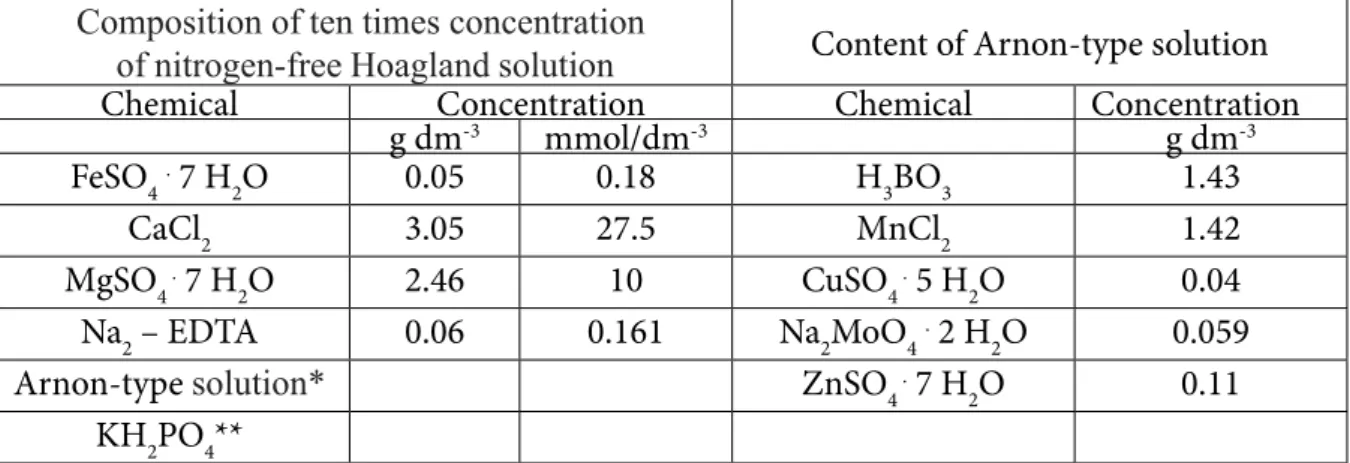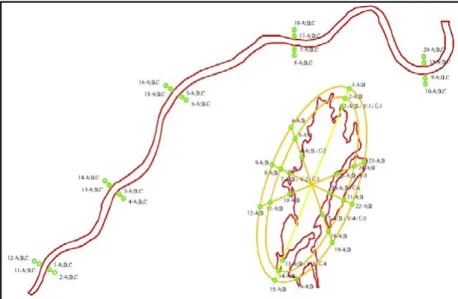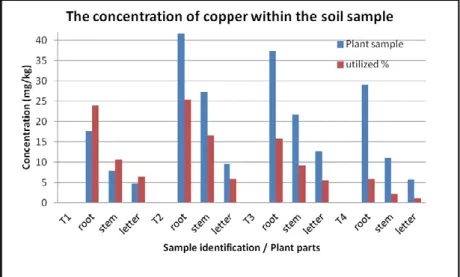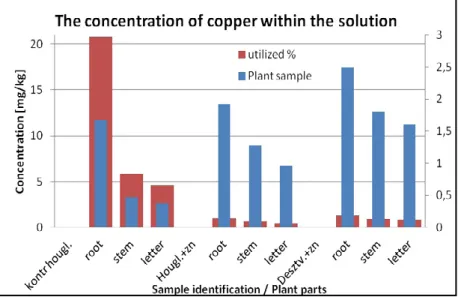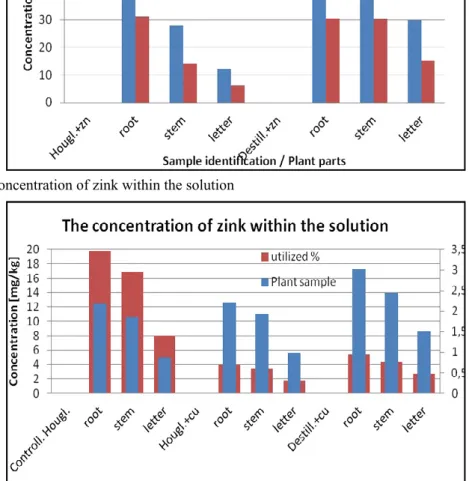Evolution of the absorption of heavy metals in function of nutrients
Albert SZANISZLÓ – Krisztina DEMÉNY
Óbuda University, Institute of Environmental Engineering, H-1034, Budapest, Hungary E-mail: szaniszlo.albert@rkk.uni-obuda.hu
Abstract: The condition of an eco-system greatly depends on the different biotic and abiotic factors. The area along the river “Tisza” is highly imperiled by random appearance of heavy metal pollutants originated from mining accidents or other sources. Heavy metals are dangerous because of the bioaccumulation and they could be toxic or poisonous even at low concentration. The aim of our research was to test the reaction of a simplified soil-plant pot experiment, consists of garden cress (Lepidium sativum) for metal pollution close to the sanitary limiting value.
Garden cress is considered one of the most important agricultural vegetables and its short reaction time for various treatments makes this plant ideal object of eco-toxicological tests. Based on the results it is realistic assumption to expect decrease the above-mentioned flexibility character. Garden cress (Lepidium Sativum) was chosen as a test plant to simulate the accessible pollutant uptake. Additionally, Lepidium Sativum is a possible carrier of heavy metals in food chain, since it is a many-sided green vegetable consumed by humans and animals as well. The present study is undertaken to examine the level of accumulation as it is modified by a plant, if the plant growing up under other conditions. It appears how for each factor as in mobilizing heavy metals, the plant laboratory water will affect the special nutrient solution or soil pollution. Responsive changes are relevant for all of the different conditions relevant for mobile heavy metals. The accumulation levels may undergo variations in function of them. In the present study, such change is characterized by the cress garden.
Keywords: heavy metals, Cd and Cu accumulation, garden cress environmental risk, heavy metals
Introduction
The heavy metal pollution is one of the leading issues of nowadays. Heavy metal pollution can cause enormous changes in the flora and fauna community decreasing of resilience capacity of the soil, although the estimation of its danger level alters according to loadabilty of the carrier medium.
Garden cress (Lepidium sativum) was chosen as a test plant to simulate the accessible pollutant uptake (Alvarenga 2008);( Herwijnen 2008).
Additionally L. sativum is a possible carrier of heavy metals in food chain, since it is a many- sided green vegetable consumed by human beings and animals (Terbe 2000).
Nowadays alarming amount of pollution enters into the environment due to anthropogenic activities. Human health is directly endangered when these pollutants get into the food chain.
Because of the environmental pollution luckily there is an increased attention on the potentially toxic elements and on the dangers related to heavy metals (Mileston 1994, Vermes
1994). Detailed and intensive examinations are imperative in order to avoid extended and extensive contaminations (Kádár 1995). Wide range of technologies are available to remediate the contaminated soils however, most of these methods are costly and non aesthetic solutions (Yoon et al. 2006).
The most polluting heavy metals include cadmium (Cd), copper (Cu), lead (Pb) and zinc (Zn), while iron (Fe) and manganese (Mn) can be contaminating in large amount (Fomes et al 2009, Filep 2002).
The metals and their compounds make a significant impact on most of the biological processes. The metals can be broken down biologically, accumulate in living organisms, toxic compounds in the subsequent biochemical reactions may occur over (Kadár and Morvai 2007; Smolinsk and Cedzynska 2007).
If large amounts of toxic materials get into the soil, the adsorption and precipitation reactions become dominant. Acidification of the soil in turn significantly increases the quantity of
mobile ions, the concentration of the metal ion in solution. Acidification is specially dangerous in already polluted areas, because the insoluble state of heavy metal compounds can cause serious environmental damage to the soil when they are mobilized (Yoon at al. 2006).
According to our knowledge the essential elements for the plants can be devided the ones, that are required in relatively large quantities (macro-elements H, C, N, O, Mg, P, S, K and Ca), and those which are need only in a small amount (micronutrients: C, Cl, V, Mn, Fe, Cu, Zn and Mo). However, as the experimental techniques are getting more and more precise, the number of microelements that are important for the plants will continue to grow (Győri 1998, Luo and Rimmer 1995).
Materials and methods Sampling
During earlier investigations it was found those samples that’s Cu and Zn concentrations exceeded the pollution limits or approached it.
Into these soil samples was planted cress seeds and after 14 days the Cu and the Zn concentration were determined in the roots, stems and leaves with FAAS method. The physical parameters of the plants (e.g. root length, stem length, leaf surface) were determined in each case.
In the experiment was placed 2 cm sample of the cress seeds were sowed into 50 ml beakers.
During the experiment, the soaked seeds were kept wet with distilled water.
The contamination happened with 0.56 mg Cu2+, and 1.965 mg Zn2+. The experiment happened in containers, that were specially designed for the rearing of plants occurred. Into the containers were sprayed 150-180 pieces of cress seeds by water. Previously these were soaked in distilled water (for 10-20 minutes) and then there were placed them on the web that layed in the containers. The cups had a 4 cm diameter and 2-3 cm thick. After the plants were contaminated, the liquid in the pot to the roots was always refilled until the net.
Besides the above mentioned container cress was planted into petri dishes, too. The contamination occurred the same level, 0.56 mg and 1.965 mg Cu2+ Zn2+ solution. Within the petri dishes 6 grams of cress was groved. This is 15-20 times more that the plants mentioned at paragraph 2.
The Petri dishes had 15 cm of diameter, lined with filter paper. The amount of seeds that was spread onto the surface was 6 g. The plants were kept wet by distilled water after the pollution.
They were treated for three days.
Preparation of the Hoagland solution
The medium was prepared on the day of use: 100 cm3 Hoagland stock solution was diluted to 1 dm3, while KH2PO4 to 5 cm3 of the stock solution was added. The pH is could be set to approximately 6 with adding 1 mol dm-3 NaOH (approx. 0.6 cm3).
Composition of ten times concentration
of nitrogen-free Hoagland solution Content of Arnon-type solution
Chemical Concentration Chemical Concentration
g dm-3 mmol/dm-3 g dm-3
FeSO4. 7 H2O 0.05 0.18 H3BO3 1.43
CaCl2 3.05 27.5 MnCl2 1.42
MgSO4 . 7 H2O 2.46 10 CuSO4 . 5 H2O 0.04 Na2 – EDTA 0.06 0.161 Na2MoO4. 2 H2O 0.059
Arnon-type solution* ZnSO4 . 7 H2O 0.11
KH2PO4**
* - Before filling the stock solution up to 1 cm3, 20 cm3 of Arnon-type solution was added to the flask.
** - From the potassium-dihydrogen phosphate we create a separated a stock solution (111,62 dm-3), which was supplemented with trace elements, we only add it to the nitrogen-free Hoagland stock solution while diluting.
Table 1. The composition of ten times concentration of nitrogen-free Hoagland solution and content of Ar- non-type solution
Monitoring of soil pollution
Sampling: 50 soil and 4 control samples were collected from 0-30 cm (A) and 70-100 cm (B) depth along Szabolcsveresmart settlement, which frequently called Rétközi reservoir (located in Szabolcs – Szatmár – Bereg county, GPS coordinates: N: 48.29340° E: 22.03357°).
Samples were taken according to the sampling network based on standards no. MSz 21470-50 (Msz. 2007).
After transport to the laboratory, samples were left to dry by exposing to the air. In order to remove the bigger stones and remnants of roots, the samples were sifted through a 2 mm sieve.
Dry weight content and pH determination:
Determination of dry weight content and pH were made according to standards no. MSz-08- 0205-1978; MSz-08-0206/2-1987 (Msz. 1978, Msz. 1987).
Phytoextraction experiment
Phytoextraction processes with L. sativum in soil were conducted under laboratory condition.
General treatment of the seeds:
4 containers were filled the soil derived from Rétközi reservoir (see on Figure 1.: 17-A; 20- A; T-A; T-B). Three replicated were used in all variants. The soil type is Eutric Cambisol (WRB reference). 4 soil samples (T-1 to T4) with outstanding value of concentration (compared
to the average value) were used. The bio cress seeds, produced by BIOrganic Ltd, were scattered over the soil. Small amount of soil was sprinkled lightly over them, just to cover. A spray bottle was used to keep the seeds evenly moist. They sprouted after 2-3 days. 0.2 g (138 pieces) seeds were used for one experiment. The seedling occurred at room temperature (between 18- 23 °C). At the end of 14th day, the full-grown plants were removed and carefully washed off.
The redundant water was done away and every plant was separated into roots, stems and leafs.
The parts of the plants were digested as it is described below.
Microwave digestion Sample preparation:
Soil: at first samples were sifted through a 0.2 mm sieve. 0.5 g dry matter soil was taken into each teflon bomb. Then 5 cm3 65% HNO3 and 2 cm3 30 % H2O2 were added before starting the digestion program.
Plant: The preparation of plant samples happened the same way, but different quantity of acids were added: 6 cm3 65% HNO3, 1 cm3 30 % H2O2. Digestion:
Samples were digested by a MILESTONE 1200 Mega Microwave Digester (see the digestion program in Table 3. – (Terbe 2000)).
Determination of heavy metal content:
After the procedure described above the
Figure 1. The “Rétközi” lake sampling points, which shows the location of the sampling grid patterns.
following elements were measured by ICP- OES and FAAS: Al, Ca, Cr, Cu, Fe, Ni, Mg, Mn, Pb, Zn in soil and Zn, Cu in garden cress.
Monitoring of the soil pollution
It became clear after completing the variance analysis (ANOVA one-way test) that the heavy metal content of the soil samples significantly depends on the place of sampling. Only one soil sample’s Cu concentration (sample id.:
22-A, see on Figure 1.) 84,8 mg kg-1 was higher than the limit value (75 mg kg-1) based on the Governmental Regulation 6/2009. (IV.
17.) KVVM-EÜM-FVM. In the case of other measured elements neither of them exceed the limit values after summarizing all the results.
These results will be used as reference base of a long term monitoring system. The reason 22-A was not take into account is that the seed sprouting was inhibited at that degree of pollution causing the insufficient quantity of plant dry mater for the analysis.
Other parameters
Soil tests should be taken into properties of soils, because the soil plays an important role in the biosphere of the transformation of materials, environmental protection (Győri 1998). Therefore, it is necessary to identify and take account of the different properties of the
soil. These parameters were performed (Table 2) on the basis of Győri (1998).
Phytoextraction experiment
It has to be taken into consideration, that soil parameters have notable effect on these experiments: metals, heavy metals, cations are not so mobile in carbonaceous soil (Kádár and Morvai 2007). The transfer coefficient (T %) was calculated, too (Formes et al. 2009). Although the organic matter content is determinant regarding the heavy metal concentration of the soil solution, straight correlation cannot be demonstrated by adsorptional experiments. The reason for this is pH affects the creation of metalorganic complexes and there is a strict correlation between pH and the degree of absorption.
Another important factor beside this is that the structural diversity of the mouldmaterial, which is not mapped completely yet, cannot be regarded as a uniform material. Their absorption and cation-exchanging characteristics are different and depend on pH (Luo and Rimmer 1995).
It can be concluded that in almost every case the heavy metal concentration in the roots were significantly higher than in the other plant parts (see on Figures 2,3). It is favorable for the consumers because heavy metals accumulate only in a small proportion in leafs and stalks of the garden cress.
ATI UNICAM 939 AAS was used for determination of heavy metal concentration.
Results and Discussion
Evaluating the CU concentration
The soil samples for the enrichment of heavy
Steps Time [min]
Soil / Plant
Process [Watt]
Soil / Plant
1. 5 / 2 Digesting, 250 / 250
2. 2 / 2 Aeration
3. 5 / 6 Digesting, 400 / 250
4. 5 / 5 Digesting, 250 / 400
5. 7 / 5 Digesting, 700 / 600
6. 5 / 5 Aeration
Table 2. Digestion program
Table 3. Pyisical and physico-chemical characteristic and composition (dry weight basis) of studied soils
The soil* Concentrations (mg/kg in dry matter)
T-1 T-2 T-3 T-4 T-1 T-2 T-3 T-4
SP* (KA) 30 28 55 44 Zn 165.6 32.2 189.9 42.3
CaCO3 (%) 1 1 1 1 Cd 23.0 10.8 41.4 14.7
Humus (%) 2.2 2.3 2.3 2.3 Cr 2.8 4.0 0.9 3.6
C/N ratio 16.7 12.4 15.0 14.4 Al 1630.7 3519.3 1031.5 2411.2
pH (H2O) 5.70 6.20 7.12 5.97 Pb 3.4 2.0 1.4 1.6
pH (KCl) 5.69 6.19 7.13 5.89 Ni 1.9 2.2 0.6 1.9
DM* (%) 98 99 99 97
* Values of the polluted sediment sample in the „Tisza” (T-1 to T-4);
SP = soil plasticity (KA). DM = dry matter conten
metals in the accumulation of plants 20 mg / kg concentration limit varies. The higher the C / N ratio of soil, and the acid-base sensitivity of the soils neutral pH (5.6) produces the utilization value of around 25%. Declining C / N ratio and the effect of increased metal concentrations to around 5% decrease in utilization. The parts of the plant does not determine the extent of the accumulation. The root part of the largest accumulation, while the smallest part of the letter.
The liquid phase accumulation of heavy metals in plant samples grown Cu concentration ratio of deficit to alter the accumulation of plant parts.
The parts of the plant does not determine the extent of the accumulation. The root portion of the maximum accumulation, but is similar to the degree of drying sections. The soil grown
plants stems the accumulation of Cu accumulates at higher rates.
The medium plant samples grown heavy metal accumulation does not alter the rate of accumulation of deficits Zn concentration in plant parts. The parts of the plant does not determine the extent of the accumulation. The same plants grown in soil accumulation rate takes place.
The utilization rate minimal however, shows a utilization of around 1%. The pollution-free medium, this value of high C / N and the neutral pH plants grown in soil samples is identical.
Evaluating the Zn concentration
The soil samples for the enrichment of heavy metals in the accumulation of plants 10 mg / kg concentration limit varies. The higher the C/N
Figure 2. The concentration of copper in the soil pattern increased in plant.
Figure 3. The concentration of copper in the solution pattern increased in plant.
ratio of soil, and the acid-base sensitivity of the soils neutral pH (5.6) produces a value of around 32% utilization. Declining C / N ratio and the effect of increasing the metal concentration decreases utilization at around 21%. The parts of the plant does not determine the extent of the accumulation. The root part of the largest accumulation, while the smallest part of the letter.
The medium plant samples grown changing the ratio of Cu concentration of heavy metal accumulation in plant parts into deficit accumulation. The extent of the parts of the plant concentrates the accumulation of plant root and stem area. The utilization ratio of the control sample shows a high utilization of 20%.
Contrary, the utilization is less than 5% of the
value of the distilled water and the contaminated medium.
The liquid phase plant samples grown heavy metal accumulation rate of accumulation of deficits Zn concentration in plant parts shifts. The extent of the parts of the plant accumulation shifts in the utilization rate of the same proportion. The root and stem part of the largest accumulation, but the minimum leaf sections. Accumulation in soil grown plants showed only a result of the control medium
Conclusions
The medium and the biological functions of plants grown in soil do not differ from each other.
Figure 4. The utilize percentage of copper in the solution
Figure 5. The concentration of zink within the soil sample
The plants grown in different medium heavy metal contamination in soil more sensitive to the pest picture. The nutrient composition of the plants can positively influence the accumulation ability. The plant parts may be increased from the root and shank portions of the rate of accumulation and uptake rate of the contamination. In contrast to soil, the plant nutrient solution less sensitive to degree of contamination. Seedlings thus a higher ability to remove impurities of the contaminated medium.This investigation is in accordance with other authors’s results of garden cress test, which show the highest accumulation
were happened in the root (Smolinks 2007).
The test area can also specify the location of the akumulation for determining cress, but the concentration of pollutants. Case of both the heavy metal concentration results in a higher accumulation of the root.
The case of minor concentrations of the same extent in all parts of the plant. Since it is proved the garden cress was able to absorb and translocate heavy metals, it creates an opportunity to apply it in fitoremediation processes. The heavy metal removal from the ecosystem via melioration in all case increases its resilience.
Figure 6. The concentration of zink within the solution
Figure 7. The utilize percentage of zink in the solution
References
Alvarenga P. et al.: 2008. Evaluation of tests to assess the quality of mine-contaminated soils. Environ Geochem Health, 30: 95-99. DOI 10.1007/s10653-008-9147-z
Dr. Győri Dániel (1998): Helyszíni és laboratóriumi talajvizsgálatok, Pannon Agrártudományi Egyetem, Keszthely, 1998
Fornes F et al.: 2009. ’Alperujo’ amendment of contaminated calcareous and acidic soils: Effects on growth and trace element uptake by five Brassica species, Bioresource Technology 100: 3982-3990 https://doi.org/10.1016/j.
biortech.2009.03.050
Filep Gy., Kovács B., Lakatos J., Madarász T., Szabó I.: 2002. Szennyezett területek kármentesítése, Miskolci Egye- temi Kiadó, Miskolc, 1-483.
Herwijnen R. van et al.: 2008. The effect of two different composts on the performance and metal uptake of popular growing on heavy metal contaminated soil. Seesoil, 17: 39-48. DOI: 10.4236/ajps.2011.25079
Kádár I.: 1995. Contamination of soil- plant- animal- human food chain with chemical elements in Hungary.
Környezet-védelmi és Területfejlesztési Minisztérium MTA Talajtani és Agrokémiai Kutató intézete, Budapest Kádár I. - Morvai B.: 2007. Ipari- kommunális szennyvíziszap – terhelés hatásának vizsgálata tenyészedény – kísér-
letben, Agrokémia és Talajtan, 56: 333-352. https://doi.org/10.1556/Agrokem.56.2007.2.10
Luo Y. – Rimmer L. D.: 1995. Zinc-copper interaction affecting plant growth on a metal-contaminated soil. Envi- ronmental Pollution 88: 79-83. https://doi.org/10.1016/0269-7491(95)91050-U
Magyar szabvány, A talaj fizikai és vízgazdálkodási tulajdonságainak vizsgálata, MSz-08-0205, 1978
Magyar szabvány, A talaj egyes kémiai tulajdonságainak vizsgálata. Laboratóriumi vizsgálatok., MSz-08-0206/2, 1987
Magyar szabvány, Környezetvédelmi talajvizsgálatok. Az összes és az oldható toxikuselem-, a nehézfém- és a króm(VI)tartalom meghatározása, MSz 21470-50, 2006
Milenston: Cookbook for MILESTON 1200 Mega Microwave Digester: 1994. The digestion program described in Microwave Acid Digestion.
Smolinsk B.- Cedzynska K.: 2007. EDTA and urease effects on Hg accumulation by Leopidium sativum. Chemo- sphere, 69: 1388-1395. https://doi.org/10.1016/j.chemosphere.2007.05.003
Terbe I., Fehér M.: 2000. Levélzöldségfélék (Type of leafvegetables). Dinasztia Kiadó, Budapest, 175-182
Vermes L.: 1994. Some questions of the soil pollution. (A talajszennyezés néhány kérdése.) Talajvédelem. 2: 86-93.
Yoon J. – Cao X. – Zhou Q. – Ma L. Q.: 2006. Accumulation of Pb, Cu, and Zn in native plants growing on a contaminated Florida site. Science of the Total Environment 368: 456-464. https://doi.org/10.1016/j.scito- tenv.2006.01.016
